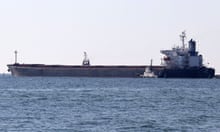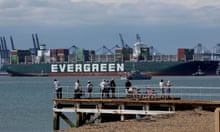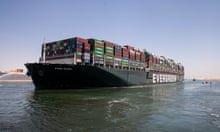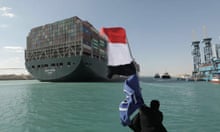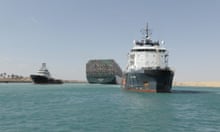Salvage teams succeeded on Monday in freeing a massive container ship that had been stuck in the Suez canal for the past seven days, blocking billions of dollars’ worth of cargo from crossing one of the world’s busiest marine waterways.
Insurers, the shipping industry and the thousands of businesses reliant on container goods were still counting the cost of the accident as traffic resumed in the evening with more than 422 vessels, carrying a vast range of items from crude oil to cattle, waiting to cross.
A fleet of tugboats and days of intensive dredging were given a helping hand by tides that swelled to their highest point with the full moon to free the 220,000-tonne Ever Given and haul it towards a lake between the north and south end of the canal, where the ship could undergo technical inspection, canal authorities said.
“Admiral Osama Rabie, head of the Suez Canal Authority (SCA), has announced the resumption of shipping traffic in the Suez canal,” the SCA said in a statement.
Television footage showed tugboat crews sounding their foghorns in celebration after the Ever Given, a cargo megaship the length of four football fields, was dislodged from the banks of the Suez.
“We pulled it off!” said Peter Berdowski, the chief executive of the Dutch salvaging firm Boskalis, which was hired to assist in the process. “I am excited to announce that our team of experts, working in close collaboration with the Suez Canal Authority, successfully refloated the Ever Given on 29 March at 15.05 local time, thereby making free passage through the Suez canal possible again.”
He said 30,000 cubic metres of sand had been dredged to help free the vessel, which had been pulled free using 13 tugboats.
Satellite data from MarineTraffic.com confirmed the ship was moving away from the shoreline towards the centre of the canal.
The obstruction has created a massive traffic jam in the vital passage, costing global trade between $6bn (£4.3bn) and $10bn a day according to one estimate and straining supply chains already burdened by the coronavirus pandemic.
The SCA said the waterway would be open 24 hours a day and the backlog of hundreds of vessels could be cleared in about a week. The delay has cost the Egyptian government about $90m so far in lost fees.
“The [Ever Given] came out intact and it has no problems,” Rabie told the local Nile TV. “We’ve just searched the bottom and soil of the Suez canal and thankfully it is sound and has no issues, and ships will pass through it today.”
The Ever Given was being inspected in Great Bitter Lake with officials to decide whether the Panama-flagged, Japanese-owned ship, hauling goods from Asia to Europe, can continue to its original destination of Rotterdam, or if it will need to enter another port for repairs.
There were cheers at the site on Monday morning when the stern of the vessel was successfully rotated about 80%, the most visible sign of progress so far in a week-long campaign that had failed to noticeably budge the vessel.
Early in the afternoon, Egypt’s president, Abdel Fatah al-Sisi, released a statement declaring the ship was free and casting the operation as a national victory. “Today, Egyptians have been successful in putting to an end the crisis of the stranded ship in the Suez canal, despite the enormous complexity surrounding the process,” he tweeted.
The canal, a symbol of independence and pride since it was nationalised in 1956, had been dug by “their grandparents with the force of their bodies”, Sisi said. “Egyptians have proved today that they are still up to the task.”
The success of the salvaging mission had been hard to judge for the first five days as excavators and dredgers worked to remove thousands of cubic metres of thick sand in which the megaship had become jammed.
Salvagers had succeeded in freeing the ship’s rudder on Friday night, raising hopes the end was in sight, until rising tides undid the work. By Sunday, Sisi was talking of the need to lighten the ship, a delicate and time-consuming process that was considered one of the worst-case scenarios.
All the while, an Egyptian team working with Japanese and Dutch consultants dredged, dug and pulled around the clock, hoping to make enough progress to take advantage of favourable tides early in the week that provided their best chance to refloat the container ship.
The financial data firm Refinitiv said on Monday the accident was costing the state-owned Suez Canal Authority about $16m a day in lost revenues.
Each day of the blockade may have been costing global trade about $6-10bn, according to a study published on Friday by the German insurer Allianz.
The crisis has prompted new questions about the shipping industry, an on-demand supplier for a world now under pressure from the coronavirus pandemic.
“We’ve gone to this fragile, just-in-time shipping that we saw absolutely break down in the beginning of Covid,” said Capt John Konrad, the founder and CEO of the shipping news website gCaptain.com. “We used to have big, fat warehouses in all the countries where the factories pulled supplies. Now these floating ships are the warehouse.”
Even with the vessel released, it could be several days before other ships can sail through the canal, said a Greek sea captain whose oil tanker is stuck behind the Ever Given. “According to the canal’s rules they have to remove it.”
Konstantinos Arletis told Mega TV on Monday, when asked if other vessels would be able to sail past the ship: “Other ships aren’t allowed to sail next to it … we’re being told an inspection has to be conducted first to see what damage the canal has sustained and if repairs are needed,” he said, explaining that if other ships traversed the waterway they could further damage the affected area.
“When they tugged the ship quite a lot of sand was dislodged, which has changed the depth of the canal.”

The Ever Given became jammed diagonally across a southern section of the canal in high winds early on 23 March, halting traffic on the shortest shipping route between Europe and Asia.
At least 369 vessels were waiting to transit the canal, Rabie said, including dozens of container ships, bulk carriers, oil tankers and liquefied natural gas or liquefied petroleum gas vessels.
Many other ships have already been rerouted around South Africa’s Cape of Good Hope in order to circumvent the Suez blockage, although the 5,500-mile (9,000km) diversion takes seven to 10 days longer and adds a huge fuel bill to the trip between Asia and Europe.
Agencies contributed to this report
